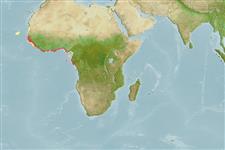Common names from other countries
>
Elopiformes (Tarpons and tenpounders) >
Elopidae (Tenpounders)
Etymology: Elops: Greek, ellops = a kind of serpent (Ref. 45335).
More on author: Regan.
Environment: milieu / climate zone / depth range / distribution range
Écologie
marin; saumâtre; profondeur ? - 50 m (Ref. 118623). Tropical; 22°N - 7°S, 26°W - 13°E (Ref. 118623)
Eastern Atlantic: West African coast from Mauritania to the Democratic Republic of Congo (Ref. 2844, 4445, 81265). It is often confused with Elops lacerta (Ref. 81265).
Taille / Poids / Âge
Maturity: Lm ? range ? - ? cm
Max length : 90.0 cm TL mâle / non sexé; (Ref. 81265); common length : 60.0 cm TL mâle / non sexé; (Ref. 2683); poids max. publié: 5.9 kg (Ref. 40637)
Épines dorsales (Total) : 0; Épines anales: 0. Diagnosis: Elops senegalensis is often confused with Elops lacerta, from which it is distinguished by a smaller number of gill-rakers on the lower limb of the first gill arch, being 11-15 vs. 17-19; and a greater number of small scales in the lateral line, 92-100 vs. 72-83 in E. lacerta (Ref. 2844, 81265).
Coastal pelagic species, occurring inshore and some way up the tidal rivers to the edge of the shelf (Ref. 4445). Feeds on fish and shrimps (Ref. 28587).
Life cycle and mating behavior
Maturities | Reproduction | Spawnings | Egg(s) | Fecundities | Larves
Schneider, W., 1990. FAO species identification sheets for fishery purposes. Field guide to the commercial marine resources of the Gulf of Guinea. Prepared and published with the support of the FAO Regional Office for Africa. Rome: FAO. 268 p. (Ref. 2683)
Statut dans la liste rouge de l'IUCN (Ref. 130435)
CITES (Ref. 128078)
Not Evaluated
Menace pour l'homme
Harmless
Utilisations par l'homme
Pêcheries: commercial; pêche sportive: oui
Outils
Articles particuliers
Télécharger en XML
Sources Internet
Estimates based on models
Preferred temperature (Ref.
115969): 23.8 - 28, mean 26.7 (based on 68 cells).
Phylogenetic diversity index (Ref.
82804): PD
50 = 0.5176 [Uniqueness, from 0.5 = low to 2.0 = high].
Bayesian length-weight: a=0.00589 (0.00256 - 0.01357), b=2.99 (2.79 - 3.19), in cm Total Length, based on LWR estimates for this (Sub)family-body shape (Ref.
93245).
Niveau trophique (Ref.
69278): 3.6 ±0.60 se; based on food items.
Fishing Vulnerability (Ref.
59153): High vulnerability (56 of 100).
